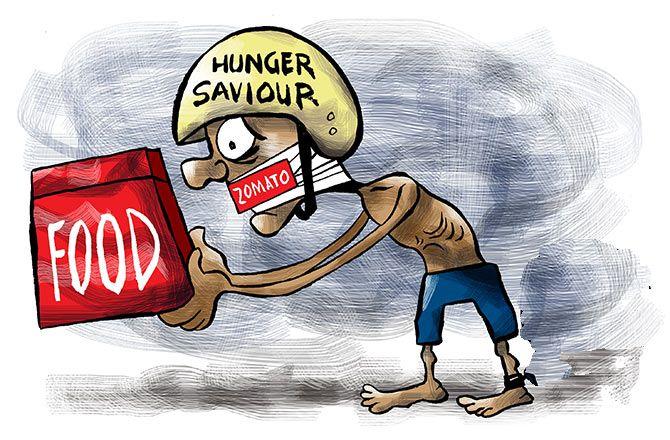Why the Zomato stock is getting hammered on markets

Given that there has been no negative news flow around Zomato, analysts believe it’s time to lap up the shares at lower levels.
The shares of food delivery giant Zomato topped the Rs 100-mark on Tuesday after they surged 10 per cent on the BSE.
In comparison, the benchmark S&P BSE Sensex ended 0.6 per cent higher. From its Monday’s low of Rs 84 — which was also its 52-week low — the stock staged a massive recovery of 19.5 per cent today.
Shares of the company have been facing massive selling pressure over the past few days as panic selling gripped global stock markets, and especially tech companies. Its shares have corrected 24 per cent over the past five sessions and have crashed a staggering 40.5 per cent from their 52-week high level of Rs 169, touched on November 16, 2021.
This seems largely driven by a correction in global tech names where US’ Nasdaq index is down 15.7 per cent on a year-to-date (YTD) basis, DoorDash 24.9 per cent, Delivery Hero 30.3 per cent, and Deliveroo 24.1 per cent. Relatively, domestic benchmark Sensex dropped over 5 per cent in the last five days, data shows.
However, given that there has been no negative news flow around Zomato, analysts believe it’s time to lap up the shares at lower levels.
“The recent correction in prices of Zomato is an opportunity for long term investors to add this stock to their portfolio as there is no company-specific reason for the correction. With Zomato planning to expand its business, its outlook appears to be constructive,” said Likhita Chepa, Senior Research Analyst at CapitalVia Global Research. She has a target price of Rs 115 from 8-10 months’ perspective.
According to domestic brokerage Kotak Institutional Equities, Zomato and Swiggy control almost all of the food delivery market.
As per disclosures provided by Prosus, which is a division of Naspers and a 36 per cent shareholder in Swiggy, Swiggy’s food delivery gross merchandise value (GMV) was $984 million in the first half of calendar year 2021 (H1CY21) while Zomato’s food delivery GMV was $1.05 billion during the same period.
This, the brokerage says, indicates some market share gain by Zomato over the period.
“While we don’t yet have data for periods subsequent to H1CY21, we note that no new competitor has entered the market and do not expect a marked difference in relative market shares in H2CY21,” it added.
Industry data shows food delivery giants’ business grew 140 per cent CAGR over 2016–19. Going-forward, Edelweiss Securities expect them to deliver a 22 per cent CAGR over 2019–30.
“This would catapult the industry size to $35 billion, or 16.2 per cent of total by 2030, from 4.2 per cent currently, even topping current penetration in mature markets such as the US (6 per cent), South Asia (10.2 per cent) and China (15.6 per cent),” they brokerage said.
Secondly, there are expectations that Zomato will increase its investments over the next 6-12 months as it moves towards making its mark in the hyperlocal grocery delivery space.
“Zomato bought a 9 per cent stake in Grofers (now Blinkit) for $100 million. It also has minority stakes in Magicpin and Shiprocket. We, however, believe that value accretion from these smaller investments may take time to realize,” analysts at KIE said.
Yet, with nearly $1.9 billion of cash as of September 2021, Zomato remains well capitalised to fund its losses and carry out fresh investments in Grofers, it added.
JM Financial believes the implication of these strategies is that Zomato, in the near term, may continue to outperform Swiggy in the food delivery vertical. In the long run, it will have to find a way to consolidate one or more of its investments to expand its horizon.
From a long term perspective, Edelweiss Securities opine adjacencies — side orders — can add value to the company’s business.
“We do see opportunities in adjacencies though: cloud kitchen, table booking, advertisements restaurant supplies, etc. While Zomato is committed to staying away from cloud kitchens, it can exploit consumer insights to create better products and capture a higher share of the value chain, a la private labels in e-commerce,” it said in a report released in November last year.
We estimate Zomato would clock a 50.6 per cent revenue CAGR over FY21–25, riding a 46.1 per cent CAGR in delivery volumes. As it focuses on gaining scale and market share, we estimate contribution profit per order would drop to Rs 7.6 in FY22 (Rs 20.5 in FY21) and increase to Rs 16.6 by FY25. Zomato would turn in positive cash EBITDA by FY24E, but would report positive EBITDA in FY26 due to high ESOP costs, it added.
For Kotak Institutional Equities, Zomato could turn EBITDA breakeven by FY25 adjusted for ESOP expense.
“The food delivery business offers solid long-term growth potential. Cities with higher density of restaurants are witnessing much better contribution margins than nascent cities; their relative mix may impact near-term margins although we retain our expectation of BUY with an unchanged fair value of Rs 170,” the brokerage said.
That said, global brokerage JPMorgan believes it is “too early to bottom fish”.
“Given that a significant part of its future cash-flows are back-ended, Zomato’s sensitivity to weighted average cost of capital (WACC) assumptions, which is led by interest rates, are sharper. Should interest rates keep rising, Zomato may have more downside scenarios than upside,” it said.
From a relative valuation perspective, Zomato trades at a 7.8x EV/adj. revenues, which is 4x global peers and 2.5x adjusted for its superior growth. This, it says, appears to overpay for stronger medium-term growth (GMV/revenue growth is 1.5x/2x peers) and market structure, ignoring the challenges of much lower average order value (AOV) and potential high discounts. It is “underweight” on the stock with a target price of Rs 120.
Source: Read Full Article

